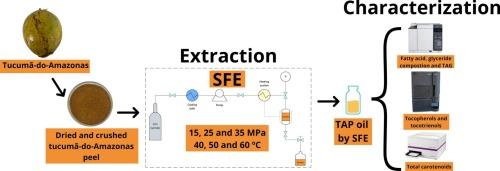Supercritical fluid extraction of oil from spent Tucumã-do-Amazonas (Astrocaryum aculeatum) peel
IF 8
1区 农林科学
Q1 FOOD SCIENCE & TECHNOLOGY
引用次数: 0
Abstract
Supercritical fluid extraction (SFE) was applied to obtain oil from the tucumã-do-Amazonas (Astrocaryum aculeatum) peel (TAP). SFE was performed using CO2 as solvent at different pressures and temperatures. The extracts were characterized for their global yield, lipid content, fatty acid and triacylglycerol profiles, carotenoid and tocopherol content and infrared spectra by FTIR. Mathematical modeling of the SFE curves was also performed using the three-line Spline model. The global yield was approximately 17 g/100 g TAP, with the oil consisting mainly of triacylglycerols of oleic, linoleic, palmitic, and stearic acids, and carotenoid content of 80.62 mg β-carotene/100 g extract and 13.49 mg β-carotene/100 g TAP obtained at 35 MPa and 40 °C. The observed FTIR spectra are similar to those reported in the literature for other vegetable oils, exhibiting minor differences in band frequency and transmittance intensity. The three-line Spline model successfully described the kinetic behavior of SFE for TAP, indicating that SFE at 35 MPa and 40 °C is an efficient method for obtaining oil from TAP with an extraction time of 40 min. Therefore, TAP can be considered a potential source of bioactive compounds that can be recovered using SFE, an environmentally sustainable extraction method, allowing this residue to be repurposed into a potential oil suitable for food, health, and cosmetic applications.

超临界流体萃取亚马孙树(Astrocaryum acleatum)果皮废油
采用超临界流体萃取法(SFE)从仙人掌 -do- amazonas (Astrocaryum aculeatum)果皮(TAP)中提取油脂。以CO2为溶剂,在不同压力和温度下进行SFE实验。利用FTIR对提取物的总收率、脂质含量、脂肪酸和三酰甘油含量、类胡萝卜素和生育酚含量以及红外光谱进行了表征。采用三线样条模型对SFE曲线进行了数学建模。全球产量约为17 g/100 g TAP,油主要由油酸、亚油酸、棕榈酸和硬脂酸三酰基甘油组成,类胡萝卜素含量为80.62 mg β-胡萝卜素/100 g提取物和13.49 mg β-胡萝卜素/100 g TAP在35 MPa和40°C下获得。观察到的FTIR光谱与文献中报道的其他植物油相似,在频带频率和透射强度上有微小的差异。三线样条模型成功地描述了SFE对TAP的动力学行为,表明35 MPa和40℃的SFE萃取时间为40 min,是一种有效的从TAP中提取油的方法。因此,TAP可以被认为是生物活性化合物的潜在来源,可以使用SFE回收,这是一种环境可持续的提取方法,允许这种残留物被重新利用成一种潜在的油,适用于食品、健康和化妆品应用。
本文章由计算机程序翻译,如有差异,请以英文原文为准。
求助全文
约1分钟内获得全文
求助全文
来源期刊

Food Research International
工程技术-食品科技
CiteScore
12.50
自引率
7.40%
发文量
1183
审稿时长
79 days
期刊介绍:
Food Research International serves as a rapid dissemination platform for significant and impactful research in food science, technology, engineering, and nutrition. The journal focuses on publishing novel, high-quality, and high-impact review papers, original research papers, and letters to the editors across various disciplines in the science and technology of food. Additionally, it follows a policy of publishing special issues on topical and emergent subjects in food research or related areas. Selected, peer-reviewed papers from scientific meetings, workshops, and conferences on the science, technology, and engineering of foods are also featured in special issues.
 求助内容:
求助内容: 应助结果提醒方式:
应助结果提醒方式:


